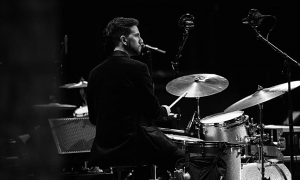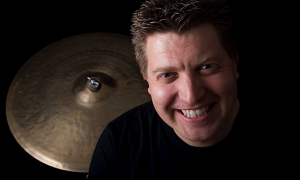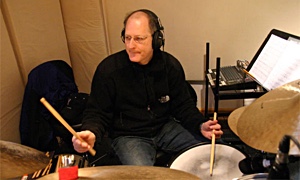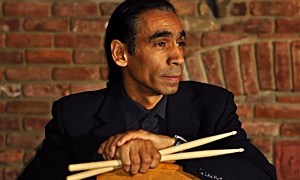Home » Jazz Articles » Rhythm In Every Guise » Lewis Nash: Inside "Monk's Dream"
Lewis Nash: Inside "Monk's Dream"
 Throughout a rendition of Thelonious Monk's composition "Monk's Dream, Lewis Nash's drumming is a study in contrasts wrapped in a smooth, calculated exterior. During the "A section (played 3 times) of Monk's 32-bar tune, Nash puts himself on equal footing with the other instrumentalists (pianist Mulgrew Miller, vibraphonist Steve Nelson, and bassist Peter Washington), without ever forsaking the drummer's traditional role as a timekeeper. He establishes an unwavering pulse but never rides a cymbal for more than a bar or two at a time. Virtually every drum and cymbal is briefly featured, yet there's nothing skittish or uncertain about what he's doing.
Throughout a rendition of Thelonious Monk's composition "Monk's Dream, Lewis Nash's drumming is a study in contrasts wrapped in a smooth, calculated exterior. During the "A section (played 3 times) of Monk's 32-bar tune, Nash puts himself on equal footing with the other instrumentalists (pianist Mulgrew Miller, vibraphonist Steve Nelson, and bassist Peter Washington), without ever forsaking the drummer's traditional role as a timekeeper. He establishes an unwavering pulse but never rides a cymbal for more than a bar or two at a time. Virtually every drum and cymbal is briefly featured, yet there's nothing skittish or uncertain about what he's doing.Although Nash stays busy, he doesn't come close to dominating the music. Using the contours of Monk's tune as a guide, he plays in unison with key segments of the melody, anticipates or cues others, executes a variety of fills, then keeps straight time on the ride cymbal during the eight-bar "B section. Nash is restless and impossible to pin down. In one instance, he fills up 3 beats of empty space with a hissing hi-hat figure (shades of Max Roach) which charges against the beat. The next time he plays a prim, melodic-sounding stick shot and tom-tom combination that doesn't affect the flow.
For all of Nash's activity there's a selfless, almost modest quality to his drumming. Everything he plays relates to the melody and complements the sounds made by the rest of the band. During one brief interlude his neat eighth-note triplets and variations move from one tom-tom to another, beginning as a fill then working in unison with the first notes of Monk's line. In terms of projection, Nash keeps himself on a very short leash. Despite the considerable momentum he generates, there's no sense of letting go or of blowing off steam. Think of the clearly delineated strokes of a classically trained percussionist in a jazz context. He employs closed rolls to the snare, flams to the snare and tom-toms, as well as single strokes and short combinations to the snare, tom-toms and cymbals. His playing invokes the image of an eclectically decorated space in which everything is painstakingly arranged.
A fastidious tuning of the drums complements Nash's sticking. The tom-toms have a nice warm sound—not unlike hand drums—and don't ring too much. His snare makes a dry brittle snap that works particularly well at low and middling volume levels.
 During Nelson's three-chorus solo Nash displays some diverse comping skills. For the first sixteen bars, while Miller lays out, you can hear the drummer's ride cymbal to its best advantage as he works hand-in-glove with Washington's walking bass line, and sometimes varies the cadences so the odd stroke or two stands out. When the pianist enters Nash immediately picks-up on what he's doing, easily placing accents on and around Miller's chords with the snare, bass drum, and a partially closed hi-hat cymbal. On the last bar of Nelson's first chorus, single strokes to the tom-tom subtly march against the beat, extending well into the next measure and briefly creating another level of rhythmic tension. In Nelson's last chorus, Nash signals the bridge by playing Morse code-like figures to a tom-tom; then he jumps on Miller's repetitive riff, each time utilizing four strokes to the tom-toms followed by a single hit to the bass drum combined with a light cymbal crash.
During Nelson's three-chorus solo Nash displays some diverse comping skills. For the first sixteen bars, while Miller lays out, you can hear the drummer's ride cymbal to its best advantage as he works hand-in-glove with Washington's walking bass line, and sometimes varies the cadences so the odd stroke or two stands out. When the pianist enters Nash immediately picks-up on what he's doing, easily placing accents on and around Miller's chords with the snare, bass drum, and a partially closed hi-hat cymbal. On the last bar of Nelson's first chorus, single strokes to the tom-tom subtly march against the beat, extending well into the next measure and briefly creating another level of rhythmic tension. In Nelson's last chorus, Nash signals the bridge by playing Morse code-like figures to a tom-tom; then he jumps on Miller's repetitive riff, each time utilizing four strokes to the tom-toms followed by a single hit to the bass drum combined with a light cymbal crash.
Nash's 32-measure solo is boosted by Peter Washington's continuous walking line. In the midst of connecting a number of ostensibly disparate ideas, sometimes the drummer cleaves to the bassist's notes, and then seemingly abandons the path for brief tangents before once again snapping back into the fold. Nash always conveys an awareness of the tune's chord changes and basic structure, in part by fashioning transitional phrases that tie together the different sections. Aside from its internal logic, his solo is something of a roller coaster ride. At times Nash offers easy to follow segments that feature pristine sticking and footwork. In other instances dense flurries of rapid strokes express an edgy impertinence that is common to more flamboyant jazz drummers. Nash brings it back home in the last eight bars by playing figures between the snare, tom-toms and bass drum, once again finding novel ways to allude to Monk's melody.
Selected Discography
Lewis Nash, Rhythm Is My Business (Evidence)
Comments
Tags
For the Love of Jazz
 All About Jazz has been a pillar of jazz since 1995, championing it as an art form and, more importantly, supporting the musicians who create it. Our enduring commitment has made "AAJ" one of the most culturally important websites of its kind, read by hundreds of thousands of fans, musicians and industry figures every month.
All About Jazz has been a pillar of jazz since 1995, championing it as an art form and, more importantly, supporting the musicians who create it. Our enduring commitment has made "AAJ" one of the most culturally important websites of its kind, read by hundreds of thousands of fans, musicians and industry figures every month.























